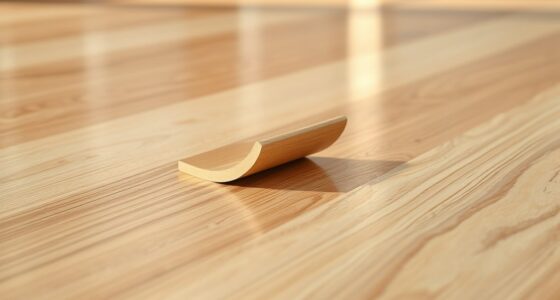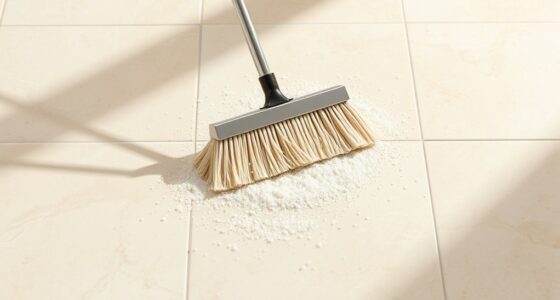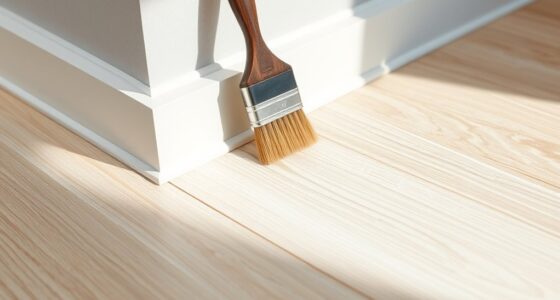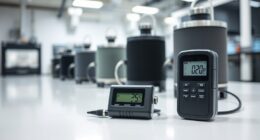To keep your garage floor scratch-free while removing sand and salt, start with a soft-bristled broom and sweep in broad, overlapping strokes. Focus on corners and edges to gather debris thoroughly. Follow up with a leaf blower or vacuum to pick up any remaining dust and tiny particles. Finish by washing with a mild detergent and a soft mop. Maintaining this routine helps prevent scratches and keeps your garage looking its best—discover more tips for a pristine floor.
Key Takeaways
- Use a soft-bristled broom to gently sweep sand and salt, avoiding stiff brushes that can scratch the surface.
- Sweep in broad, overlapping strokes to effectively remove debris without damaging the concrete.
- Focus on corners and edges where sand and salt tend to accumulate for thorough cleaning.
- Follow sweeping with vacuuming or a leaf blower to eliminate residual dust and tiny abrasive particles.
- Regularly inspect and wash the floor with a mild detergent to prevent buildup and surface deterioration.

Cleaning your garage floor might not be the most glamorous task, but it’s essential for maintaining a safe and tidy space. A clean garage not only improves the overall appearance but also reduces hazards caused by dirt, debris, and spills. When it comes to garage cleaning, one common issue many face is dealing with sand and salt, especially during winter months. These substances can be tough on your floors and can cause scratches if not handled properly. The key to effective driveway maintenance is adopting a scratch-free sweeping routine that keeps your garage floor pristine without causing damage.
Sand and salt are notorious for their abrasive qualities. When you drive in and out during winter, these particles get tracked onto your garage floor. Over time, they can lead to scratches and surface deterioration if you don’t remove them regularly. To prevent this, you should start your routine with a thorough sweep using a soft-bristled broom. Avoid stiff-bristled brushes that can scratch the concrete surface; instead, opt for something gentle but sturdy enough to lift debris. Sweep in broad, overlapping strokes to gather all the loose sand and salt, paying special attention to the corners and edges where debris tends to accumulate.
Once you’ve swept away the loose particles, consider using a leaf blower or a shop vacuum to remove residual dust and fine grit. This step ensures that no tiny abrasive particles remain that can cause micro-scratches when you move your vehicle or walk across the surface. After removing loose debris, it’s advisable to wash the garage floor with a mild detergent solution and water. Use a soft mop or sponge to clean the surface thoroughly, which helps eliminate any residual salt or grime that might have bonded to the concrete. Regularly inspecting your garage floor for signs of surface deterioration can help catch issues early and prevent costly repairs down the line.
Proper driveway maintenance isn’t just about aesthetics; it’s also about preserving the integrity of your garage floor. Regular cleaning prevents the buildup of corrosive salt that can eat away at concrete over time. By keeping sand and salt under control with a scratch-free sweeping routine, you extend the lifespan of your garage floor and avoid costly repairs. Remember, patience and consistency are key. Incorporate these simple steps into your garage cleaning routine, and you’ll maintain a smooth, damage-free surface that looks great and functions well for years to come.
Frequently Asked Questions
How Often Should I Sweep My Garage Floor During Winter?
During winter, you should sweep your garage floor at least once a week to maintain a proper winter cleaning schedule. Regular sweeping prevents sand and salt buildup, protecting your garage floor from scratches and damage. By staying consistent with your garage floor maintenance, you keep it clean and safe. Don’t forget to use a sturdy broom and focus on high-traffic areas, especially after snow or ice events.
Can I Use a Leaf Blower to Remove Sand and Salt?
Yes, you can use a leaf blower to remove sand and salt from your garage floor. A leaf blower makes debris removal quick and efficient, especially in tight corners and hard-to-reach spots. Just guarantee you use a gentle airflow setting to avoid causing scratches on the surface. Keep the blower moving steadily and wear eye protection to stay safe during the debris removal process.
What Type of Broom Is Best for Garage Floors?
You want a broom that’s gentle yet effective. Opt for a broom with soft, flagged nylon bristle types to lift sand and salt without scratching your garage floor. Choose a handle material like aluminum or fiberglass for durability and comfort. This combination guarantees a scratch-free sweep while making the job easier. Avoid stiff bristles or wooden handles that might damage your surface or cause discomfort during extended use.
Are There Eco-Friendly Options to Remove Salt Residue?
Yes, you can use eco-friendly options like biodegradable cleaners and vinegar solutions to remove salt residue from your garage floor. These methods break down salt deposits without harming the environment or damaging your surface. Simply mix vinegar with water or choose biodegradable cleaners designed for tough stains, then sweep or mop the area. This approach keeps your garage clean and eco-conscious, protecting both your floor and the planet.
How Do I Prevent Salt From Damaging My Garage’s Concrete?
To prevent salt damage and protect your garage concrete, apply a high-quality sealant before winter. This creates a barrier against salt and moisture. Regularly sweep to remove salt buildup, and consider using eco-friendly de-icing alternatives like calcium magnesium acetate. Also, promptly wash the floor after snowfalls to minimize salt contact. These steps guarantee your garage concrete remains intact and damage-free throughout the season.
Conclusion
Keep your garage floor spotless by regularly sweeping away sand and salt, especially after harsh weather. A consistent routine prevents scratches and keeps your space looking its best. Remember, a stitch in time saves nine—address small messes before they become big problems. With a little effort and regular care, you’ll preserve your garage floor’s finish and avoid costly repairs down the road. Stay diligent, and your garage will thank you for years to come.









